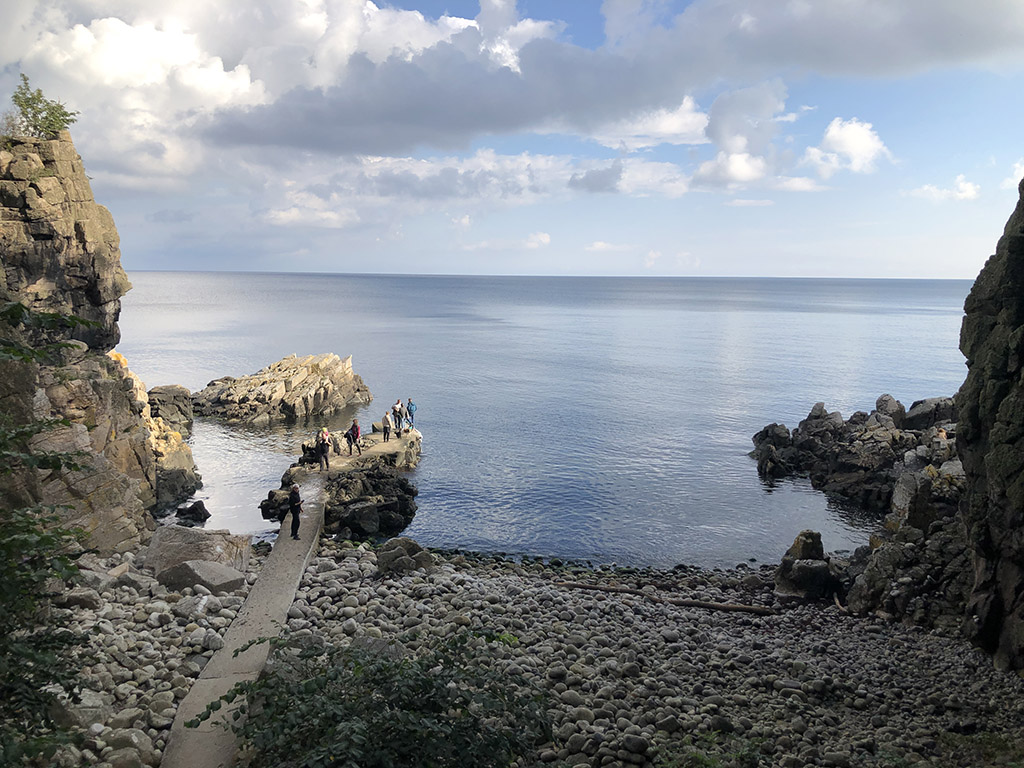Charged landscapes – reflections on Performing Landscapes Bornholm / Klippekroppe
af Kevin Doyle
I recently attended the opening day of Performing Landscapes Bornholm – Klippekroppe, presented as part of the 2023 Bornholms Kulturuge festival. Performing Landscapes is an initiative of the Copenhagen-based Metropolis organization and was billed as “a celebration of the equinox with eight stagings in eight Bornholm landscapes.” It was created in collaboration with the Bækelund International Residency Center for Artists (BIRCA) and seven individual artists based in Denmark who were hosted on Bornholm by BIRCA earlier in the year.
I stayed for the entirety of the day-long Klippekroppe program. Perhaps “stayed” is too easy of a word for what I experienced; maybe “endured” is a better choice. I arrived by bus in the Bornholm coastal town of Allinge at roughly 7:00am in advance of the first performance. I somehow lasted until 8:00pm that evening when I found myself standing in the cold with an assembled crowd on a different side of Bornholm, the vast former quarry complex of Ringebakkebruddene; to witness the final culminating group performance. During the intervening 13 hours, I traveled round the island in a clockwise manner to witness performances from the seven participating artists — Ilon Lodewijks, Dorte Bjerre Jensen, Lene Degett, Ben Woodhams, Peter Vadim, Katinka Wissing, and Manon Duquesnay — at eight different scenic landmarks on Bornholm; each setting chosen to explore the “connection between human bodies and nature’s rocky bodies.” Whether seen as a collective whole or taken on the merits of each individual artist, Performing Landscapes Bornholm – Klippekroppe revealed itself as something I did not expect it to be: an innovative and moving artistic program of the highest caliber. Klippekroppe surprised me with several discoveries and revelations; including one I did not foresee — I liked it.
I will be the first to admit I’m not the best candidate to write about Performing Landscapes Bornholm. The postcard image circulating for Klippekroppe left me unimpressed to the point of being biased. I was not enthusiastic about attending the program, as I was left with the impression that it was just a bunch of detached, “new-agey” artists dancing in the woods and clanging rocks together. Earlier this year, I lived in Ukraine for three months during a brutal winter where I gained first-hand experience of how war is deliberately inflicted upon a civilian population.
Previously, I lived and worked in Bangladesh in collaboration with six women who survived a devastating garment factory fire. It has become harder to interact with contemporary theatre and dance practitioners who do not share an awareness of genocide’s return to Europe (via Mariupol), or avoid exploring how we all benefit from the Exponential Slave Trade oppressing Bangladeshi women. Contrary to my misguided impressions, at around 8:30 in the morning last Saturday – from the opening moments at Madsebakke walking with a group of Danes led by Dutch artist Ilon Lodewijks — I had my personal biases debunked and eroded. The Klippekroppe program consistently offered up deeply moving encounters between artists, audiences, and the natural landscape of Bornholm that did not fail to provoke deeply personal moments of self-reflection.
Metropolis, Performing Landscapes Bornholm, BIRCA, and the seven individual artists themselves – all worked together in a beautiful (although likely stressful) collaboration — to provide Danish audiences with the kind of “live art” experiences only possible with public funding for culture.
Based on reactions I observed on the faces of Danes throughout the long day and night, I’d say that Klippekroppe was a success. And yes, I can confirm that rocks were clanged together.
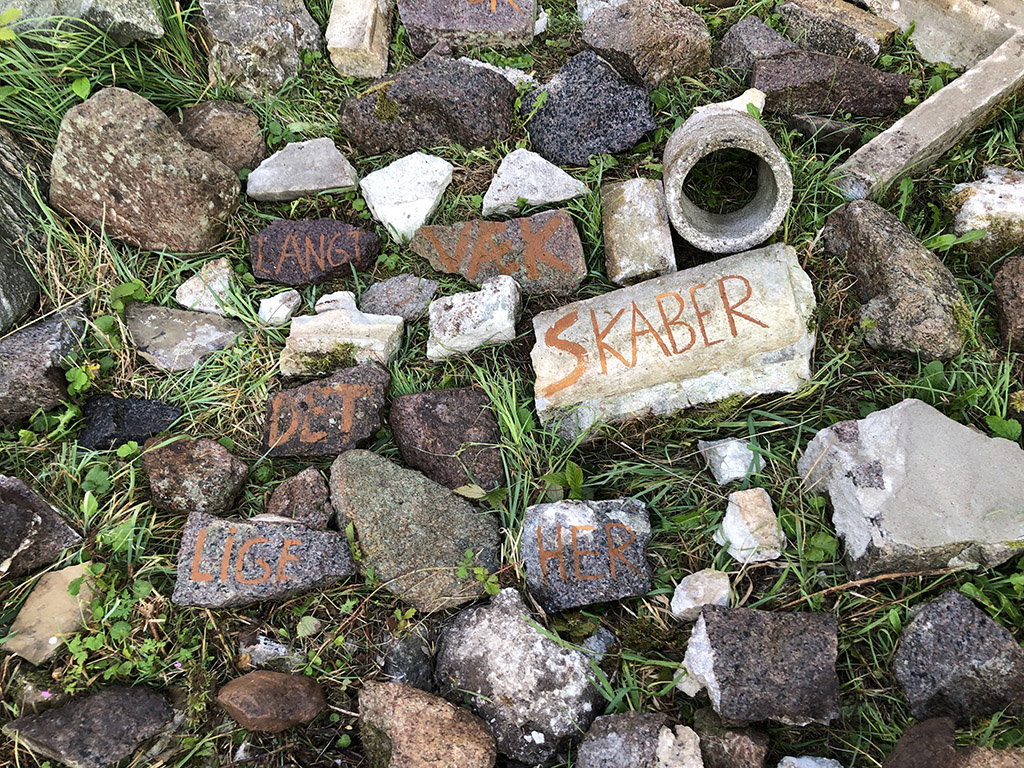 My day began at Madsebakke, a public site located outside Allinge marked by rock outcroppings that bear carvings dating from the Bronze Age. After being instructed to leave my camera gear and to not take smartphone photos, a group of maybe twenty-five attendees were led across a field by Ilon Lodewijks to arrive at a gulley below a tall rockface cliff where many stones had been deposited. Attendees noticed several of the stones bore Danish words painted upon them; as our artist-guide, Lodewijks, disappeared to scale the cliff beyond our view. The Danish words “SKABER” (creates), “LANGT” (long), and “LIGE” (just) were a few that I wrote down. Lodewijks then re-appeared atop the outcropping, chanting (or was it singing?) as she laid down to partially hang from the cliff. Her body was perfectly juxtaposed against a bright, blue sky as a warm, comforting sunshine illuminated the entire site.
My day began at Madsebakke, a public site located outside Allinge marked by rock outcroppings that bear carvings dating from the Bronze Age. After being instructed to leave my camera gear and to not take smartphone photos, a group of maybe twenty-five attendees were led across a field by Ilon Lodewijks to arrive at a gulley below a tall rockface cliff where many stones had been deposited. Attendees noticed several of the stones bore Danish words painted upon them; as our artist-guide, Lodewijks, disappeared to scale the cliff beyond our view. The Danish words “SKABER” (creates), “LANGT” (long), and “LIGE” (just) were a few that I wrote down. Lodewijks then re-appeared atop the outcropping, chanting (or was it singing?) as she laid down to partially hang from the cliff. Her body was perfectly juxtaposed against a bright, blue sky as a warm, comforting sunshine illuminated the entire site.
After some time, Lodewijks rose and gestured us to follow her up the trail and into the surrounding fields. What followed was the first occurrence during Klippekroppe of what I felt was one of the program’s strongest recurring moments — witnessing a group of people being led by an artist to traverse a stunning natural landscape. It was movingly gorgeous at times; whether intentional or not. I could not help but feel like I was participating in a procession straight out of the closing scene of Bergman’s THE SEVENTH SEAL — but instead of following Death, I was being led to a new discovery. Lodewijks led the group through a meandering path of connected circles fashioned by depressing the tall grass in advance — almost like the UFO “crop circles” that keep reappearing in fields around the world. After the fourth or fifth circular path, Lodewijks led us to a clearing where a fully-flattened circle appeared — with a bluetooth speaker and phone at its center. We were encouraged to sit down around the circle’s edges, with our backs to the speaker — looking out across the landscape of this ancient Bronze Age site overlooking the coastline of a calm blue sea.
As the first few chords of what I thought would be a cheesy “new age” soundtrack began to play — I was surprised to hear authentic audio interviews conducted in Danish and English; interviews with local residents and tourists who visit the Madsebakke site. Each shared their impressions and reflections of having a location charged with such history and memory being so commonplace; so easily accessible. After the audio ended, we were led back through the fields to the spot atop the rockface Lodewijks had hung from. It was revealed to be dotted with ancient symbols carved into the rocks hundreds of years ago. Lodewijks selected an elderly Danish woman to join her near one symbol resembling the circular paths we had walked together. What followed was the first occurrence of another strong aspect of Klippekroppe — the reactions and responses elicited in the participants. The joy in this elderly Danish woman’s smile transcended any artistic aesthetics, as she was guided by Lodewijks to lay down upon the rockface and run her elderly fingers over the ancient symbol carved there. The rest of then laid down in different locations; repeating the same gesture with rock carvings nearest to us. We laid down on the high rock outcropping, warmed by a strong September morning sun. I lay there for some time, looking up at wispy clouds passing across a blue sky backdrop — and thought about nothing at all for the first time in weeks. We all rose as a group and walked out of the site — with no one saying a word – as joggers, cyclists, and moms with carriages all stared at us wondering what was going on.
No one spoke in the car afterwards, as we were taken to the next location. Clearly wishing to linger more in the moments Lodewijks had led us to experience laying on the rocks in peace and quiet. I was grateful to not have the burden of my camera; to have been fully present for the duration of Lodewijks’ performance. I felt a sense of being grounded and connected to the Madsebakke site; even though I am not Danish, and it was my first time there. Whatever ritual Lodewijks involved us in, had an impact lasting longer than the fleeting sensations provided from a selfie or Instagram post.
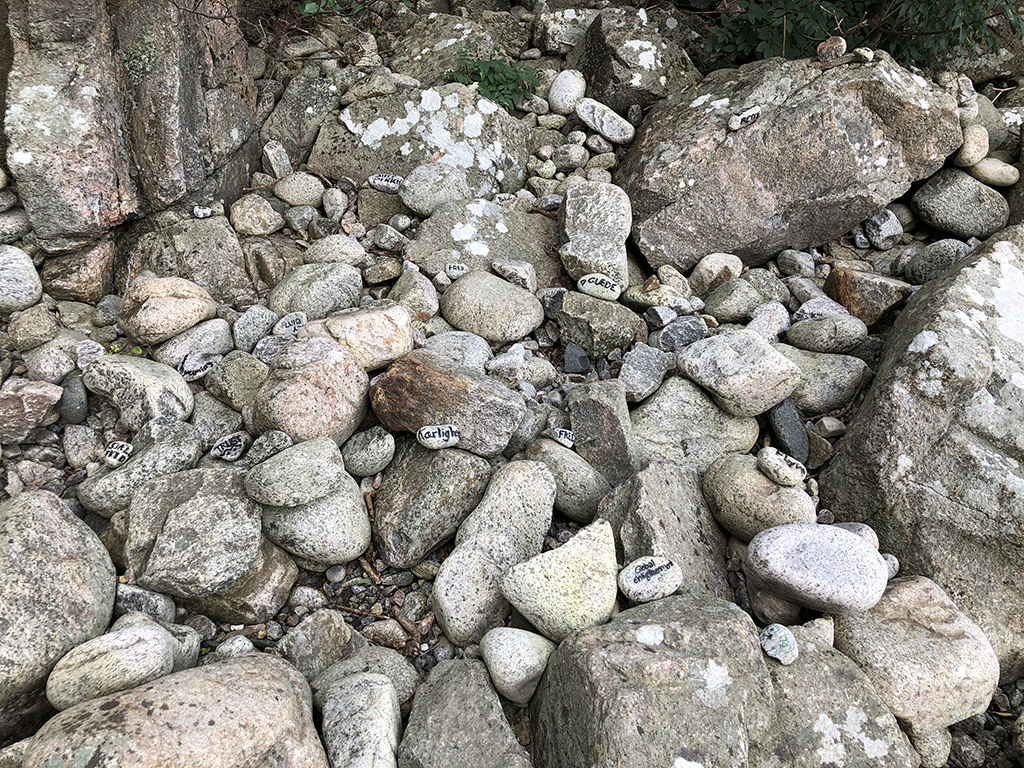 The next stop that morning was the Hellingdomsklipperne, a group of high coastal cliffs and rocks made of sharp granite, located near the Bornholms Kunstmuseum a few miles outside of Gudhjem. It was here that Danish artist Dorte Bjerre Jensen had prepared a two-tiered healing ritual. An even larger group of attendees — it was later in the morning now — were led down a trail through fields behind the museum; a herd of grazing cows stared at us nonchalantly as we passed by in single file. After Jensen performed a solo choreographic work, we assembled in a circle near the top of the stairs that led down to the sea. Jensen stood in the center dressed in long black robe; presumably near the site of a holy spring that once attracted pilgrims during the Middle Ages. Small drinking glasses, groupings of stones pre-planted with dabs of fresh paint, and a thin paintbrush were waiting for us at each of our places around the circle. Jensen asked us to close our eyes while she spoke and proceeded to pour a reddish liquid into our glasses; referencing a healing spring that has been brought back to life. After instructing us to re-open our eyes, Jensen asked us to “Drink from me” and then requested that we each paint a phrase or word that expressed our own individual deepest wish. Jensen handed out a piece of writing — a poem (of sorts) in English translation, titled “Rø Kjijla” (or, “the holy spring”) — which partially read: “I appear from the deepest layers of the cliffs // I’m almost nothing, yet everything // I’m the insisting roots, the cell fluids of plants, and whisper of bodies.” The action of drinking together combined with Jensen’s tone, reminded me of attending my local Catholic church in New York as a child; the part where the priest would offer up communion for blessing before distribution. Each participant painted a word-phrase on their chosen rock, and then Jensen asked us to exchange our rock with another participant and tell them our wish. I do not recall the Danish word given to me, but I wrote my phrase — “To Have Been Better” — for some reason, thinking of times in the past when I failed my own family or a previous girlfriend.
The next stop that morning was the Hellingdomsklipperne, a group of high coastal cliffs and rocks made of sharp granite, located near the Bornholms Kunstmuseum a few miles outside of Gudhjem. It was here that Danish artist Dorte Bjerre Jensen had prepared a two-tiered healing ritual. An even larger group of attendees — it was later in the morning now — were led down a trail through fields behind the museum; a herd of grazing cows stared at us nonchalantly as we passed by in single file. After Jensen performed a solo choreographic work, we assembled in a circle near the top of the stairs that led down to the sea. Jensen stood in the center dressed in long black robe; presumably near the site of a holy spring that once attracted pilgrims during the Middle Ages. Small drinking glasses, groupings of stones pre-planted with dabs of fresh paint, and a thin paintbrush were waiting for us at each of our places around the circle. Jensen asked us to close our eyes while she spoke and proceeded to pour a reddish liquid into our glasses; referencing a healing spring that has been brought back to life. After instructing us to re-open our eyes, Jensen asked us to “Drink from me” and then requested that we each paint a phrase or word that expressed our own individual deepest wish. Jensen handed out a piece of writing — a poem (of sorts) in English translation, titled “Rø Kjijla” (or, “the holy spring”) — which partially read: “I appear from the deepest layers of the cliffs // I’m almost nothing, yet everything // I’m the insisting roots, the cell fluids of plants, and whisper of bodies.” The action of drinking together combined with Jensen’s tone, reminded me of attending my local Catholic church in New York as a child; the part where the priest would offer up communion for blessing before distribution. Each participant painted a word-phrase on their chosen rock, and then Jensen asked us to exchange our rock with another participant and tell them our wish. I do not recall the Danish word given to me, but I wrote my phrase — “To Have Been Better” — for some reason, thinking of times in the past when I failed my own family or a previous girlfriend.
Dorte Jensen then instructed us to walk down the long stairs that leads to the stone pier where the Hellingdomsklipperne (or “Sanctuary Rocks”) meets the sea; requesting that we all “Descend with me.” Step-by-step, the entire group of participants made their way down at their own pace, assembling at the base of the steps to place the painted rocks we were given alongside hundreds of others that have broken off and been deposited over thousands of years; just to left of the stone pier. With our painted rocks out of our hands, we noticed that Jensen had left the group. Eventually, she reappeared on a cluster of large rocks on the opposite side of the small cove — naked and exposed — moving slowing, almost crawling alongside another artist, Peter Vadim, who was also naked and exposed. Both artists, also trained as dancers, performed a tedious, meandering choreography crawling across the rocks as tides from a gentle sea struck the cove where we had assembled. Vadim and Jensen seemed lost, almost like newborns, trying to find their way upon the rocks. Neither artist truly looked up, their heads pointed down. Finally, Vadim came to a stop — laying in a prone position on his stomach — almost at rest; seemingly either from exhaustion, or loneliness. Eventually, Jensen found him, coming to rest herself by laying atop and across Vadim’s back. After some time of rest had elapsed, Jensen and Vadim stirred into movement, then disappeared behind the rocks. The “performance” or ritual was over.
Several participants lingered for a long time down in the cove at the Hellingdomsklipperne. The sound of the tides was hypnotic. It was the second experience of the morning where no one truly spoke. As they departed, participants took one long, last look at the painted rocks — perhaps considering their greatest wish (or regret) — then began the slow journey up the steep flights of stairs that leads out of the Hellingdomsklipperne.
It was on the way up that I noticed the reactions and responses that had been elicited within the participants of our group. It was clear everyone had left something profoundly personal and meaningful painted onto their rocks down in the cove. We had all descended down together, as Jensen had requested, and something had been left behind or was rediscovered as a result of that descent. As we finally found our way back to the top and the sun and the grass fields and the observant cows — I happened to catch one of the most beautiful moments from the entire day’s program. A mother and her tall teenage daughter, walked together a few paces ahead of me through the trail. The daughter had her arm stretched across her mother’s shoulder and back as they walked; almost comforting her mother. Neither of them said a word, but the image of that gesture stayed with me for the entire day. It represented one of the strengths of the Performing Landscapes Bornholm – Klippekroppe program. Participants had meaningful encounters and experiences with the artists, the natural environments, and with each other — but on their own secret terms. Those encounters cannot be traced or quantified by any standard system of measuring audience engagement used at performing arts institutions. But the experiences did take place; they do possess an inherent and genuine social value. Sitting in the car as we drove to the next destination, one participant remarked about her experience: “You cannot just scroll down.”
The Bornholm artist, writer and teacher Lene Degett was the next artist on the program. We were taken to assemble at a “Bautasten” site located just to the south of Svaneke. The bulk of this performance from Degett was in spoken Danish, so unfortunately there was much I did not understand. But this did not mean that the encounter carried any less meaning. Bornholm is the one place in Denmark that contains the most bautasten; which are ancient, elongated stones without inscriptions that usually stand on a ridge close to streams or along the coasts. Some are connected to locations where remains are buried. More than 1,000 bautasten are officially registered across Bornholm, and our group of participants — which had increased in number yet again — assembled in a parking lot near two of them.
Our group was led to the two bautasten by the usage of a long “rope” made of scented twine and moss. Each member of the group passed along towards the bautasten site by handing off the long moss-twine to whomever came next; taking care not to let the moss-twine return to the ground until all had passed. Lene Degett recited a section of writing standing adjacent to the two bautasten. After we finished, each were encouraged to make physical contact with the two bautasten, as we circled round them to walk away from the site down to the second phase of Degett’s performance.
At the base of the hill, three local artisans and Degett had dug a series of eight holes with tall wooden poles placed in the mounds of dirt piled directly near each hole. Three of the artisans stood in each of their respective holes, waiting for our group to arrive. Degett joined them by entering her own hole, and proceeded to read another section of writing to us in Danish. It felt like a scene from one of Samuel Beckett’s plays; either “HAPPY DAYS” or the urns and cans he employed in “PLAY” and “ENDGAME”. The scene really did possess the sensation of set design in an outdoor theatre. After Degett was finished speaking, each artisan took their own turn to speak to us — each addressing a recent piece of their own artwork they held in their hands. One by one, they described in Danish the object they created, and then proceeded to bury their object deep in their hole; then moving to another unoccupied hole where they stood silently. For some reason, my thoughts returned again to my childhood and attending the annual Last Supper mass, where our church’s pastor would assume the humbling role of washing the actual feet of 12 different citizens. I still don’t know why I thought of this; but the feelings Degett’s “ceremony” elicited simply reminded me of this gesture. After each artisan was finished, Degett read again and handed a closed envelope to a curator from a Bornholms museum; I assume as record of each artwork now buried at the site — to hopefully be exhumed one day by distant, future generations; if the human race can still survive that long.
I could tell the performance-ritual had an impact upon all the Danes assembled in our group; because there was very little talking again as we made our way out Degett’s site and back to the parking lot outside Svaneke. It was a sad shock when the sound of car traffic from the nearby road broke over us to interrupt the silence. It felt sad and violent somehow. It was a pity to think of how quickly the experience faded away from that communal moment; to be subsumed by the sounds of road traffic, and then to hastily plan the route to the next destination in the Klippekroppe program. I guess this was one disappointing aspect of Performing Landscapes Bornholm; that each new location required a severing from the moments one just experienced to then drive to the next destination on a different part of the island. I guess it could not be avoided; especially when attempting to be in dialogue with a diverse range of geologic locations naturally occurring across Bornholm.
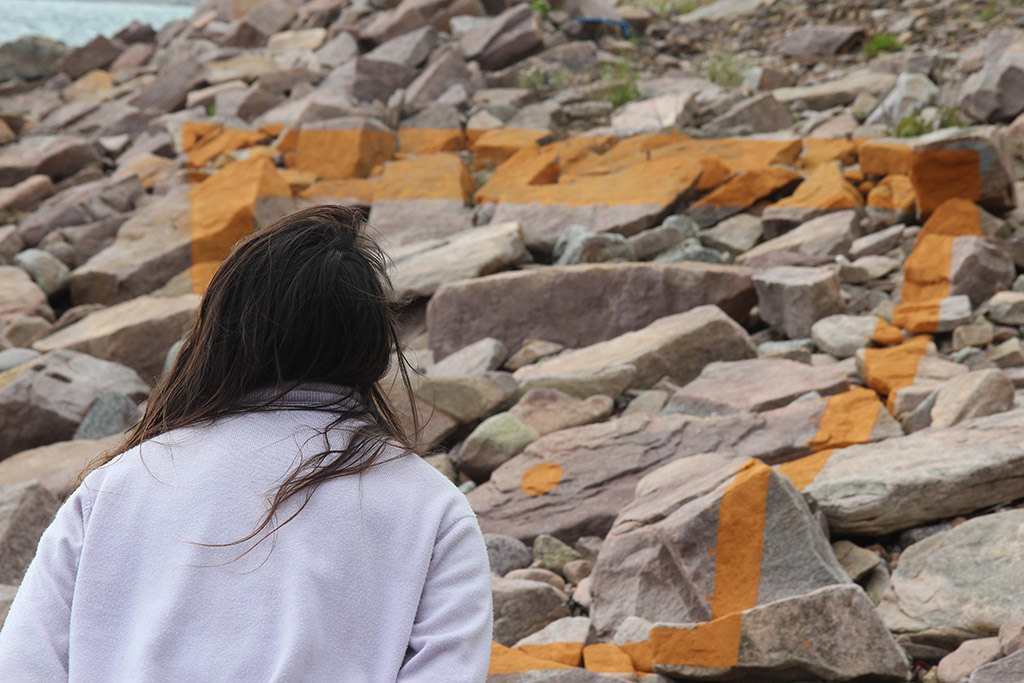 The English artist, illustrator, and educator Ben Woodhams has lived on Bornholm since 2008 with his family. Woodhams’ practice has often featured birds, but in recent years he has been “studying changes in the landscape through space and time.” For Woodhams’ part of the Klippekroppe program, he worked with students from Bornholms Biledskole to assemble two different anamorphic squares on the coastline near Frederiksstenbrudsøen at Halleklippene; just in sight of the town of Nexø to the south. This part of the program took place at 13:00. It was not as obligatory or demanding for group participation as the previous three performances. For participants like myself, committed to the entire day’s program, it provided a welcome respite and the chance to chill. Some people decided to swim in the sea, before rejoining the group to attend. Light refreshments were served by the program organizers, and participants were free to come- and-go from the worksite that Woodhams had assembled on the coast. The break and food was sorely needed and greatly appreciated.
The English artist, illustrator, and educator Ben Woodhams has lived on Bornholm since 2008 with his family. Woodhams’ practice has often featured birds, but in recent years he has been “studying changes in the landscape through space and time.” For Woodhams’ part of the Klippekroppe program, he worked with students from Bornholms Biledskole to assemble two different anamorphic squares on the coastline near Frederiksstenbrudsøen at Halleklippene; just in sight of the town of Nexø to the south. This part of the program took place at 13:00. It was not as obligatory or demanding for group participation as the previous three performances. For participants like myself, committed to the entire day’s program, it provided a welcome respite and the chance to chill. Some people decided to swim in the sea, before rejoining the group to attend. Light refreshments were served by the program organizers, and participants were free to come- and-go from the worksite that Woodhams had assembled on the coast. The break and food was sorely needed and greatly appreciated.
Woodhams had chosen as his workplace the exact demarcation line that separates two geologic zones of Bornholm. A line was painted onto the ground to indicate the spot, with Swaneke granite on the left (or south side) and Nexøsandstone on the right (or north). Program participants were informed of this, and the geologic history of the site — both in person by Woodhams (who spoke in Danish and English), and by a laminated info sheet affixed to the picnic table where we all ate and drank. Participants were told how to differentiate between the Swaneke granite and Nexøsandstone; quickly trained to identify each stone. Then, we were encouraged to locate any Nexøsandstone that naturally appeared in the granite section, and pick it up by hand to deliver it to the other side. The process was repeated with locating any Swaneke granite on the Nexøsandstone section, to also deliver it to its “proper” side. Over time, the dominant colors and features of each unique stone began to assemble with its own kind; revealing the clear demarcation line Woodhams had identified for us; marking a comparison between different geologic worlds caused by glaciers in the last Ice Age.
Woodhams and his team of students also invested time in moving other stones around the site in a different location, and painting them with an iron oxide taken from Risebækken. While not discernible from most viewpoints, if participants stood next to a tall wooden pole that Woodhams had installed at the site — and then looked south, placing one’s head just atop the pole — an anamorphic square appeared when viewed from just the correct perspective. The square appeared just like it was described in the Klippekroppe brochure materials — almost floating above the coastline like a 3-D portal at this intersection of two geologic moments. Participants would return to view it again and again, capturing the moment on their smartphones, before finally departing to arrive at the next location in the program.
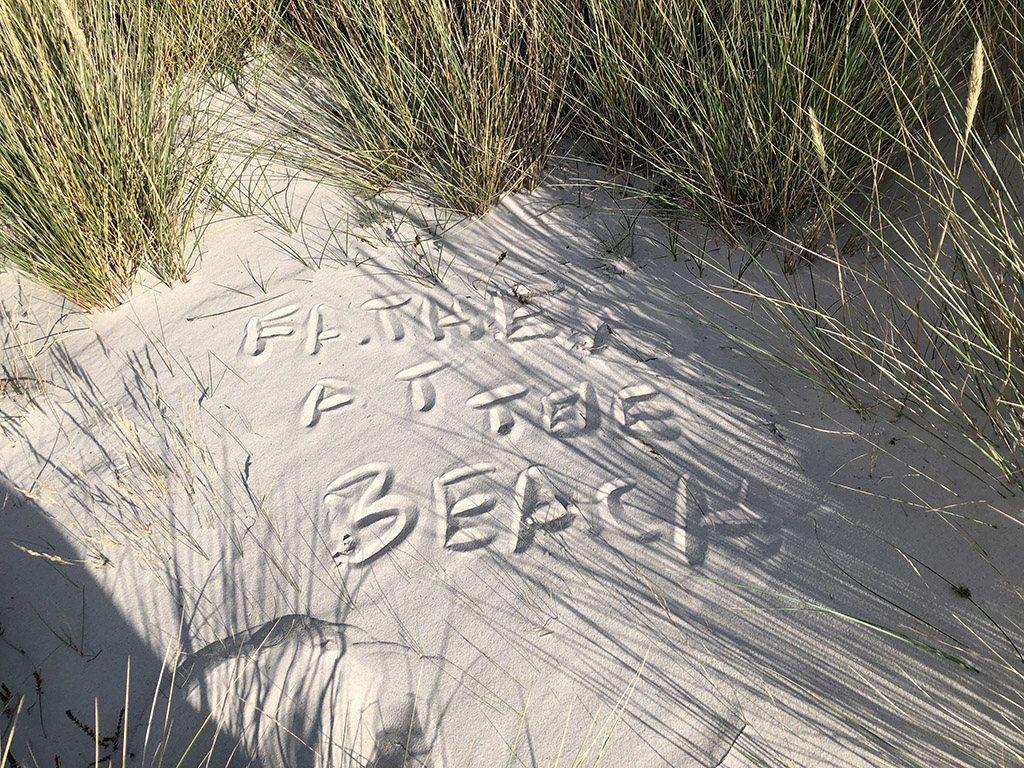 Peter Vadim’s “queer walk” though the beach dunes of Dueodde was the one performance on the program that I had been looking forward to the most. I’ve been working in residence at the Bornholms Teater in Rønne since the start of summer for a new play commission called TURIST. The beach at Dueodde had evolved into a special location for me. It was the one site on Bornholm where I had the best encounters with tourists; and the long, uninterrupted span of white beaches and sprawling dunes was the only place on Bornholm that reminded me of the Jones Beach and Robert Moses state parks I grew up with in New York with my family.
Peter Vadim’s “queer walk” though the beach dunes of Dueodde was the one performance on the program that I had been looking forward to the most. I’ve been working in residence at the Bornholms Teater in Rønne since the start of summer for a new play commission called TURIST. The beach at Dueodde had evolved into a special location for me. It was the one site on Bornholm where I had the best encounters with tourists; and the long, uninterrupted span of white beaches and sprawling dunes was the only place on Bornholm that reminded me of the Jones Beach and Robert Moses state parks I grew up with in New York with my family.
Peter Vadim did not disappoint.
The assembled group of participants stood in a parking lot near the lighthouse until we were ushered into the dunes area. We walked as a group, repeating the processional gestures from earlier in the day, to finally arrive at the crest of a large dune — overshadowed at its peak by a large tree branch that functioned almost like a framed doorway or portal into the main section of dunes. Peter Vadim emerged from a distance to meet us — meandering his way slowly through white sandy paths naturally occurring in the dunes. Vadim’s slowness was not just some meditation on distance, it was necessary because his entire head and face was seemingly encased in white sand; apparently, partially blocking his vision. He arrived at the base of the large dune we assembled upon, and gestured to follow him into the expanse. The wind had picked up significantly by now, but the bright warm sun was competing with encroaching and menacing dark clouds. The sun won the battle, as Vadim deposited grains of sand into our hands as if from an hourglass. Our group then followed Vadim to the next set of dunes. Seeing the group walk slightly ahead of me, I was reminded of the closing beach scene to Terence Malick’s THE TREE OF LIFE; where deceased family members are reunited with loved ones who have not aged. I doubt the comparison was intentional, but I mention it because the scene was so panoramic and perfect — it was like we were walking in a film. But the fantastical landscape of Dueodde was reality; and Vadim had an encounter awaiting us, planted in a nestled and secluded section of dunes.
We arrived as a group to a location where dozens of tiny, palm-sized nests were waiting for us — each with two pieces of paper folded up and tucked inside them. We were silently instructed by Vadim to choose the first paper marked with a #1 — where instructions were written for us to recall a cherished memory. We laid down in the sun and sand thinking of this memory. Then, after a time, we were instructed by the second paper marked #2 to write down our memory in the sand. I wrote: “Father at the beach” — recalling all the long summer Saturdays and Sundays of my childhood spent on the beach with my father, his friends, and their own families.
Vadim then reappeared with Dorte Jensen out in the sand, seemingly resuming their efforts from before by the sea. Both were naked and both were crawling slowly, almost searching for each again — their heads covered in sand, obscuring their vision. In some respects, it was a Part Two of the previous performance on the sea rocks; a continuation of exploring a theme that was never formally announced or framed. And I don’t think any of us in attendance required for it to be so. It was enough to watch Vadim and Jensen seek out each other in the expanse of white sand and dunes; find each other again; then disappear from our collective view. We were left standing and sitting as an assembly of participants — one by one each choosing to depart on our own time; some choosing to review what others had written in the sand, while others were satisfied to take the memory of their own writing with them back through the expanse of dunes. As we rose and fell along the walk back, the sun resumed its battle with the dark encroaching clouds and the sea roared with huge waves called forth by an increasingly violent wind that would dominate the rest of the day.
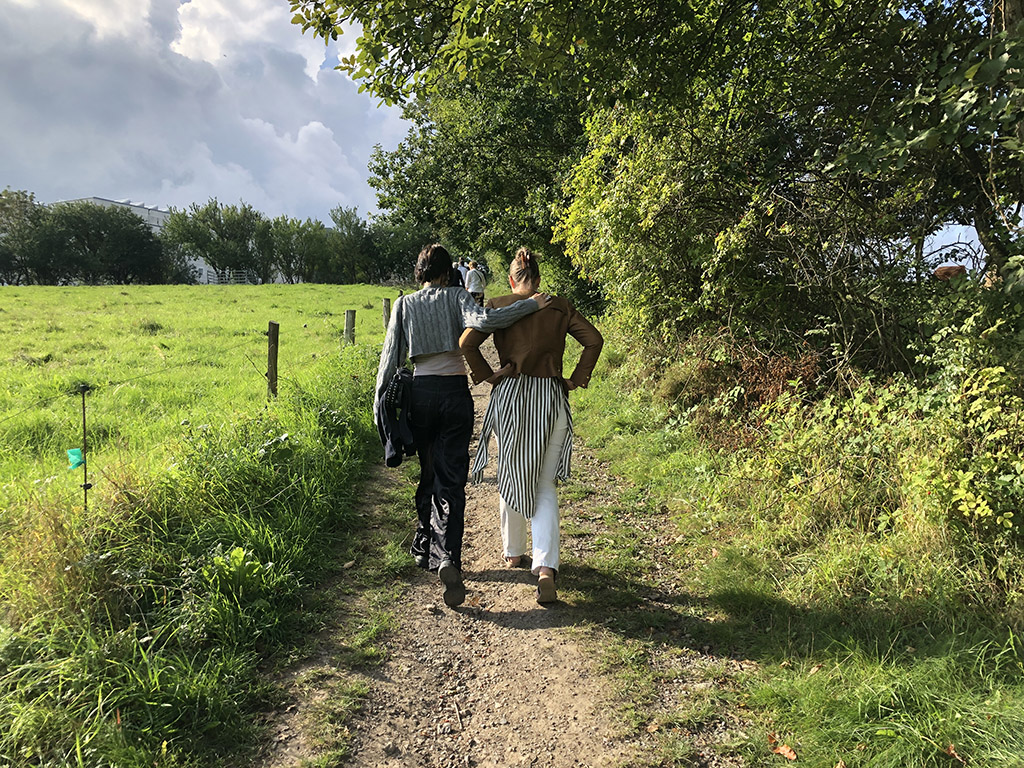
The next performance on the Klippekroppe program was perhaps the most perplexing because it did not seem to know what it wanted to be. The artist Katinka Wissing presented a piece called “The chicken hen & the rooster” at the Klintebakken fault line site adjacent to the NaturBornholm Museum Center at Aakirkeby. I had been looking forward to this performance also — due to my taking Geology courses as my science electives in college, but also to a preview excerpt showing at BIRCA held a few days earlier in the week. At that preview showing, Katinka Wissing initiated a process of handing different chosen rocks to audiences members — announcing their actual name or a fictitious, invented name — and urging us to pass the rocks along through the audience. Each interaction was deeply personal, establishing a connection between both artist and audience member; requiring us all to look each other in the eyes. I was excited to know that Wissing’s performance was happening adjacent to NaturBornholm; a site I had wanted to visit myself as part of own work for some time.
We all assembled in the parking lot of NaturBornholm as the ferocious wind began to torture us; which was somewhat unfair to Wissing. She met us near the parking lot — dressing in a matching costume with red gloves, accompanied by a second performer-dancer who appeared almost as her doppelganger. The duo led us throughout an extremely long route through the Klintebakken site — stopping at times to pick up pre-planted rocks and handing them to each participant; repeating the naming process with each rock. The exchanges were personal as you made meaningful eye contact with Wissing. We were each of us required to carry the large rock through meandering route — which felt even longer for someone who had been up since 5:00am. The merciless wind finally got to me; and sucked the energy from me — to the detriment of fully understanding the totality of Wissing’s work.
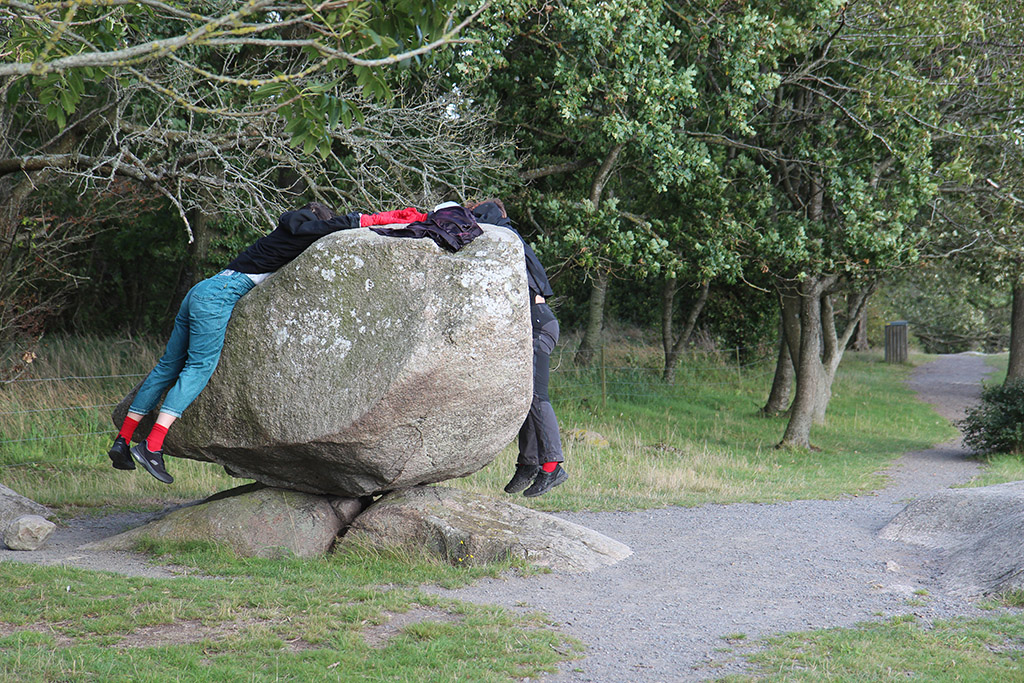
We finally arrived at a large boulder, where we were instructed silently to deposit our named stones. Chunks of frozen ice of different sizes dotted the landscape around the large boulder. Once we deposited our named stones, Wissing and her doppelganger silently climbed atop the boulder and laid face down. Then, a long process of the duo “melting” began with each of their bodies slowly sliding off the boulder. I imagine to replicate the sense of being in the last Ice Age which left it’s lasting impression on Bornholm. When the duo finally “melted” they fell off the large boulder to stand on the earth again and proceeded to lead us downhill to a different section of the Klintebakken further away from the parking lot which resembled a former quarry. Wissing and her doppelganger held hands the entire way, in a precarious dance where they pulled on each other’s weight without drawing their partner down to their own side. What seemed like the third phase of Wissing’s performance took place within the vast flat bed of what I assumed to be a quarry; consisting of the duo breaking their tenuously balanced hand-holding, then launching into a joyous dance across last sections of the space. Sadly, I did not understand it; either due to exhaustion or the terrible wind. But later, I agreed with another audience member sharing the car with me as we departed Klintebakken that Wissing’s work seemed like three performances, rather than one. Days later, I tend to agree. I feel as if each one could have been explored in greater detail on it’s own; or at least connected to only one other, rather than two. It’s running time and placement in a long day’s program was too much for me to focus upon properly.
Perhaps due to the realization that it was the final solo performance of the program — or perhaps due to the invigorating sea air — my senses returned in the port city of Rønne for a performance by Manon Duquesnay at 17:30pm.
The natural sunlight of that hour, combined with the setting and contours of the Fyldområde area of Rønne’s west harbor provided this French-Danish artist with an incredible opportunity to create in dialogue with the rocks and salt water sea. Like her colleagues that preceded her in the program at the Hellingdomsklipperne and in Dueodde, Duquesnay proved up to the challenge. She offered up an inspiring performance that felt almost like an epic film due to her precise choice of movement and stagings. Duquesney collaborated with local students in Rønne, who would appear at various intervals and moments, interspersed throughout her own main choreographic thread. She possesses an incredible sense of pacing and timing, framing our perspectives almost like a cinematographer. She seemed to innately know not only what she wanted to express and explore in her work, but also how each section of the performance would look from the perspective of the audiences behind her following on her route; as if Duquesney employed a camera crew behind her during rehearsals. She was clearly aware of composing with the entire space of Rønne’s west harbor.
Duquesnay began by coming to meet us, dressed in oversized blue overalls that made her look much younger — closer in age to the teenagers who would appear later on. With her hand, Duquesnay drew a question into the dirt-sand at our feet. A massive pile of sand was in the west harbor, and seemingly repeating a gesture that Vadim employed earlier at Dueodde, she dispensed sand into the hands of participants. She then performed a solo choreography that — to my untrained eye — was the most technical and proficient from the entire day. As she danced, Duquesnay drew closer to the large rocks that line the protective barriers in the west harbor, and would touch or embrace the rocks as she progressed along the coastline; encouraging us to interact with the large rocks, as well. Many obliged her, while others was chose to remain onlookers. After she reached the sea wall, Duquesnay faded from the performance to be replaced by a series of appearances from her collaborator students.
The first was a teenage girl who was troubled, speaking anxiously in Danish, looking downwards at an assortment of discarded stones on the jetty walkway. Eventually, the unnamed teenage girl picked up as many stones as she could carry and also disappeared from view; replaced by a teenage boy who raced and leaped across the entire landscape in a youthful, care- free manner. Duquesnay appeared again, leading us and resuming her own solo choreography passing a large rock on the jetty that had a long transcription written upon it in Danish. I still do not know what was written there — one of the drawbacks of site-specific, outdoor performances in a foreign country — but it did not prevent me from being moved by the work.
Duquesnay faded again from view, as the teenage girl reappeared hidden in an alcove of the jetty — seated, but still anxious — trying to assemble, or sort through, the jagged stones she had gathered earlier. The teenage girl spoke repeatedly in Danish as she frantically worked in the alcove; somewhat protected by the furious winds that caused the waves to increase with intensity, spraying water upon those of us closest to the sea on the jetty. I recall either Duquesnay or a second teenage girl appearing to lead us onwards, and we followed — with Duquesnay more an observer with us now; and the second teenage girl assuming the prominent role in the performance. She stood with her back to us, shouting out into the raging sea. It seemed a brave act, defiant even; as the waves grew with crashing intensity. I turned back to see the first teenage girl, now calmer, standing next to Duquesnay, watching with us. They felt like versions of their younger and older selves, with maybe a flash of the doppelganger from Witting’s performance.
We were encouraged to join the second teenage girl upon the rocks and scream out into the sea alongside her — in memory of our youth. Most of us did, screaming in our own native languages — Danish, French, English — the word “youth” or our own rallying calls to commemorate or reclaim it. As we looked out into the sunset across the remaining section of jetty, the same teenage boy reappeared in a distant section far from us. He charged out across the rocks like a parkour athlete; fearlessly leaping in a way that only the young with no consequences are capable of. Then, just as suddenly, the teenage boy vanished; and with that — the performance ended. Many of us lingered there on the jetty rocks; awakened by our own calls in the face of a raging sea. You couldn’t help but feel so incredibly (and preciously) alive.
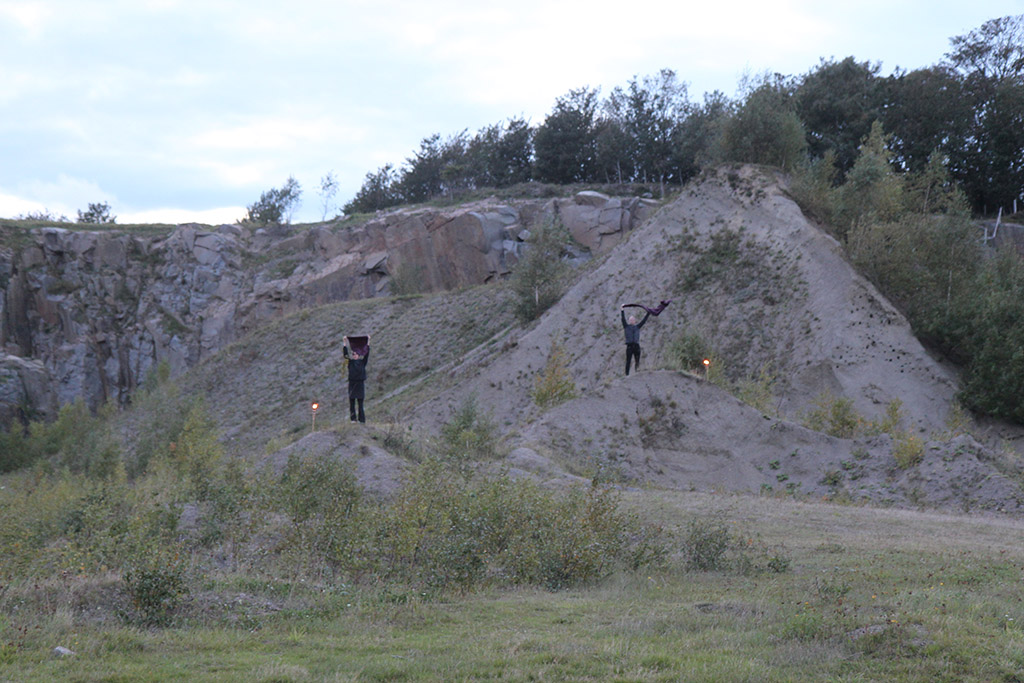 The day-long Klippekroppe program was scheduled to end at sunset with a group event consisting of all the participating artists at the Ringebakkebruddene site; north of the town of Hasle. The group driving in the car I was in decided to stop for coffee on the way; which I eagerly consumed, reaching the end of my capacity to process anymore artistic work. I also wolfed down a hearty Danish cheeseburger with my coffee, but sadly even that could not bring me back. Sadly I was not that present (or patient) for the final group showing at Ringebakkebruddene; dominated by a brutally cold wind that only grew worse in the fading light of day. The best I am capable of doing is to summarize it in brief.
The day-long Klippekroppe program was scheduled to end at sunset with a group event consisting of all the participating artists at the Ringebakkebruddene site; north of the town of Hasle. The group driving in the car I was in decided to stop for coffee on the way; which I eagerly consumed, reaching the end of my capacity to process anymore artistic work. I also wolfed down a hearty Danish cheeseburger with my coffee, but sadly even that could not bring me back. Sadly I was not that present (or patient) for the final group showing at Ringebakkebruddene; dominated by a brutally cold wind that only grew worse in the fading light of day. The best I am capable of doing is to summarize it in brief.
The Ringebakkebruddene site is a massive former quarry complex with several stages or tiers that faces the Baltic Sea. As the final section opens up to reveal an expansive wide landscape of removed earth and stone — each of the seven artists stood on large mounds of dirt at the quarry’s base. A large circle of lit, flaming torches stood in the center of the quarry, surrounded by each of the artists chanting and/or singing atop their dirt mounds. The final group of participants were lead down the massive driveway — where large trucks must have once driven constantly — to stand around a circle of fire as the sun set over Bornholm. The wind made the experience way too freezing to tolerate; and I spent most of my time trying to stay warm with my hands and torso over a burning torch.
There were many new faces in our group, people who had not participated in other performances. I wonder if they understood the group performance — as each of the seven artists made their down into the fire circle to present abbreviated remix versions of their earlier work. I appreciated this aspect of the final showing; almost like a sensory review of the day’s events. As we assembled together around the fire circle, the group rock-clanging I initially feared now finally transpired. Yet I did not seem to mind it, since I knew each of the artists better now via their performances. I was too cold and too tired to fully comprehend any deeper meaning to this culminating event. The program statement online indicates that it marked not only the end of Klippekroppe, but a “celebration of the autumnal equinox” to help usher in the end of “the Anthropocene Age” to start a new “ecocentric time” to heal and reconnect with Nature. If so, these admirable goals were completely lost on me during the group performance; which I genuinely enjoyed more as a marvel of site-specific work as opposed to digesting any urgent social message. For me, it was enough to see each of these artists again — taking their brief turn in the remix within the circle — reliving my memories and moments from their performances earlier in the day; remixing my own personal emotions of what each artist awakened in me.
Ultimately, this is what I believe to be the greatest strength of the entire Performing Landscapes Bornholm – Klippekroppe program. The committed artists and staff supported each other technically and creatively to deliver a series of meaningful encounters for audiences that serve as interventions to sever us from the flattening stream of “placeholders” on social media seen on mobile devices we fool ourselves into believing communicate authentic experiences. This Klippekroppe program required real rehearsals, actual collaborations, and advanced technical planning to pull off successfully. Each of the artists had to not only present their own work, but were required to also serve as “hosts” or greeters to audiences on behalf of their fellow artists in the program. It was all pulled off flawlessly with no mishaps. Every performance started on time in spite of complex logistics involved; staging eight performances across an entire island with a population in the tens of thousands. It all simply worked. And the artists and staff should be applauded for their efforts.
I may not have known precisely what message or meaning the artists wanted to communicate throughout the entire day — given barriers of language or my own exhaustion — but the totality of the Klippekroppe program is evidence that live arts, that performing arts, have an urgent role to play by interrupting our daily lives to create innovative, performative interventions and provide the general public with moments of self-reflection that our smartphones cannot deliver. I was grateful for the time to remember my father at the beach, or to descend down to reflect on my greatest wish. I was grateful for the feeling of being led through these landscapes, as if by a cinematographer, and to have accumulated a new sequence of memories across sites around Bornholm that I probably never would have found on my own. The entire Klippekroppe program won me over by the day’s end, overcoming my initial hesitation, to become a series of performances that are still living within me even more than a week after their viewing. And I guess that ultimately — this is all we can ask of art — that it lives with us long after the performance has ended; as we resume our toils in the steady stream of our daily lives. And for that, the seven participating artists in the Klippekroppe program should consider their site-specific creations a success.
Kevin Doyle (IE/US) is a playwright and director working between the European Union and his native New York. Currently, he is in residence at the Bornholms Teater on a new commission “TURIST” that will premiere in 2024. His previous work “SVANEKE” premiered in 2021 at the Bornholms Teater, and received a national tour of Denmark during the Fall 2022 Season. Doyle is a contributing writer at Diggit Magazine in The Netherlands. doylekevin.com
Photo: Kevin Doyle
About Performing Landscapes Bornholm – Klippekroppe / 23.-24. sept. 2023



